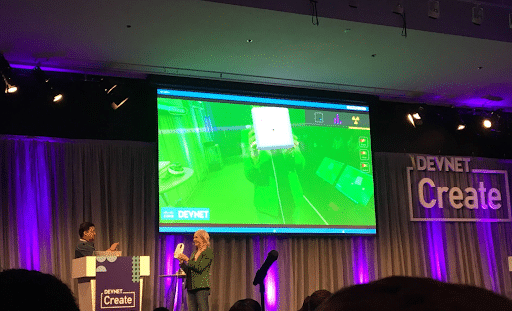Last week, I attended (for the first time) Cisco DevNet 2019. At the event, I presented how to use the NetBeez API to gather network performance metrics such as round-trip time, throughput, and packet loss from distributed monitoring agents. You can download the presentation from slide share (NetBeez Network Performance API).
I found DevNet Create extremely useful to learn more about new network technologies and trends. I was also pleased that you didn’t necessarily need to have a Cisco network to benefit from attending the event. At this event, there were several sessions that covered topics not strictly related to Cisco, but to networks and APIs in general. I was really pleased with the variety of new things I learned in just two days! The DevNet Create team really did a great job, and so did its attendees and speakers.
For this reason, I highly recommend attending next year’s DevNet Create – especially if you are a network engineer or a software developer who is interested in the latest advances of network automation and APIs. If you are a software developer working for a Cisco partner, it’s a ‘must attend’, as you may end coming up with new ideas and integrations of your solution with Cisco products. As I did.
Here, I’d like to mention some interesting sessions that I attended at Cisco DevNet Create 2019.
Cisco DevNet 2019 Opening Keynote
In the opening keynote, Susie Wee, SVP and CTO of Cisco DevNet, mentioned technologies that are destined to change our future and the way we interact with the world. While I was familiar with most of the technologies mentioned, I found the demonstrations very compelling.
Here are the demonstrations that really got my attention:
- WiFi 6 (802.11ax) – In this demo, they compared, side by side, the length of time that it takes to stream a 4K resolution video, in a crowded stadium. The smartphone with WiFi 5 (802.11ac) had a hard time to load the video (buffering), while the WiFi 6 device was already streaming it with good quality.
- Machine Learning (ML) – To demonstrate what machine learning can detect, in comparison to the human eye, they showed the video footage at a stadium; nobody in the keynote audience was able to detect a fight that was going on in the crowd, but the software pinpointed it immediately! This type of surveillance system could greatly improve security response in public venues which are extremely difficult to monitor. Personal Note: this technology could raise major concerns if improperly used.
- Augmented Reality (AR) – In this demonstration, an AR application running on a smartphone gave its user information about the WiFi access points installed in the keynote auditorium. By pointing the smartphone camera to an access point, the user was able to retrieve, in real time, useful information such as the access point’s hostname, MAC address, and serial number. The application also reported the signal strength area, as if it was a real-time 3D heat-map.
Automate Your Network with Nornir
Nornir is “an automation framework written in python to be used with Python.” This framework is very much used for network automation and to abstract inventory and task execution across multiple nodes. This all sounds very similar to Ansible. However, according to Dmitry Figol from Cisco, Nornir is more programming oriented than Ansible and, because written in Python, can be easily integrated with other Python libraries, including Pytest for network testing.
Advanced Location Analytics Using WiFi Data
Mathieu Gerard from Mapwize showed us how you can determine indoor location of WiFi clients by listening to their network probe requests from multiple access points. Another benefit of this technology is to determine the number of attendees at one venue. One interesting thing I learned is that most smartphones’ operating systems will use a random MAC address on their network probe requests to protect the privacy of their users. If you are using this type of data to estimate the number of devices in your network, it may result in inflated numbers.
Packaging Network Automations with Docker
Docker containers are becoming ubiquitous and, in some cases, a valid alternative to virtualization. More networking vendors are now supporting Docker containers on their devices. This will enable distributed applications, like NetBeez, to flourish. Greg Anuzelli, Solution Architect at Presidio Networks, introduced the basics of working with Docker containers. One caution that Greg shared with the audience is the use of 172.16/12 networks (RFC1918) on Docker containers. Since this IP space is commonly used on large networks and, if not corrected, will cause conflicts with other application or network clients. It’s required in this case, to change the default network configuration for Docker containers.
Network Data Analysis with Elasticsearch, Logstash, and Kibana (ELK)
This was one of the best sessions I have attended. Eric Chou, the speaker, is a master in network automation and python. He also co-authored two books on this topic (that I have to share here for our readers) called “Python Network Programming” and “Mastering Python Networking”. This session provided an example of how to use the ELK stack to capture, store, and analyze netflow data from network devices. If you are interested in this topic, and would like to try it yourself, check out the article “Analyzing Network Packets with Wireshark, Elasticsearch, and Kibana” that Eric wrote.
Meraki API
This session only scratched the surface of Maraki’s API. Meraki has launched a new portal solely dedicated to its API. On this portal, users can review the API documentation, find working examples, and access sandboxes to test the API functionalities. Meraki has three main API categories:
- Dashboard API – This APIs is used to provision devices, create networks, and apply other configuration settings without having to go through the dashboard; this is widely used by service provides, who use this API for OSS/BSS.
- Scanning API – The scanning APIs are mostly use to gather network metrics and performance measurements about the network.
- Captive portal API – With this API, users can create captive portals and deploy web applications to users to push survey or any other web services.
What else?
I have also recorded a video on YouTube that has a quick recap about DevNet Create 2019. You can find it here below. If you want to learn more, check out the 2019 DevNet agenda, and register to next year’s event.






